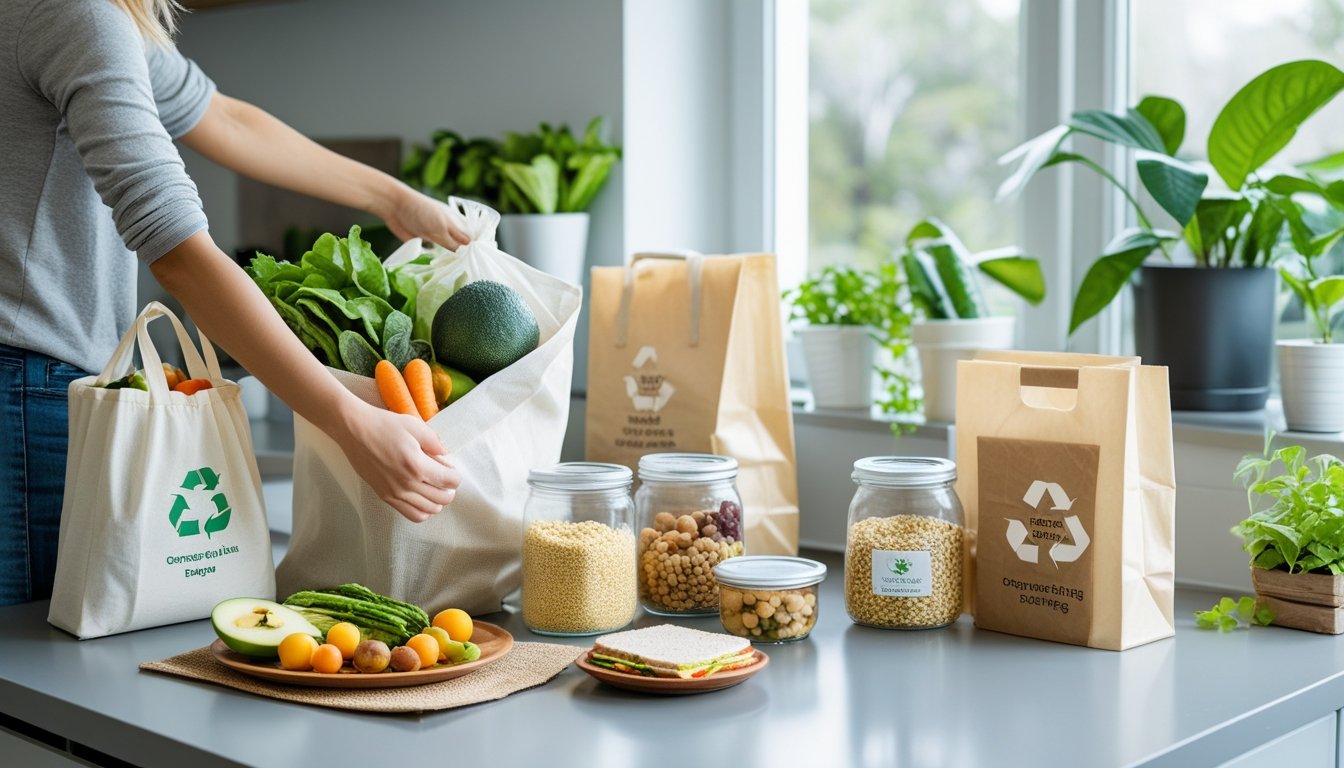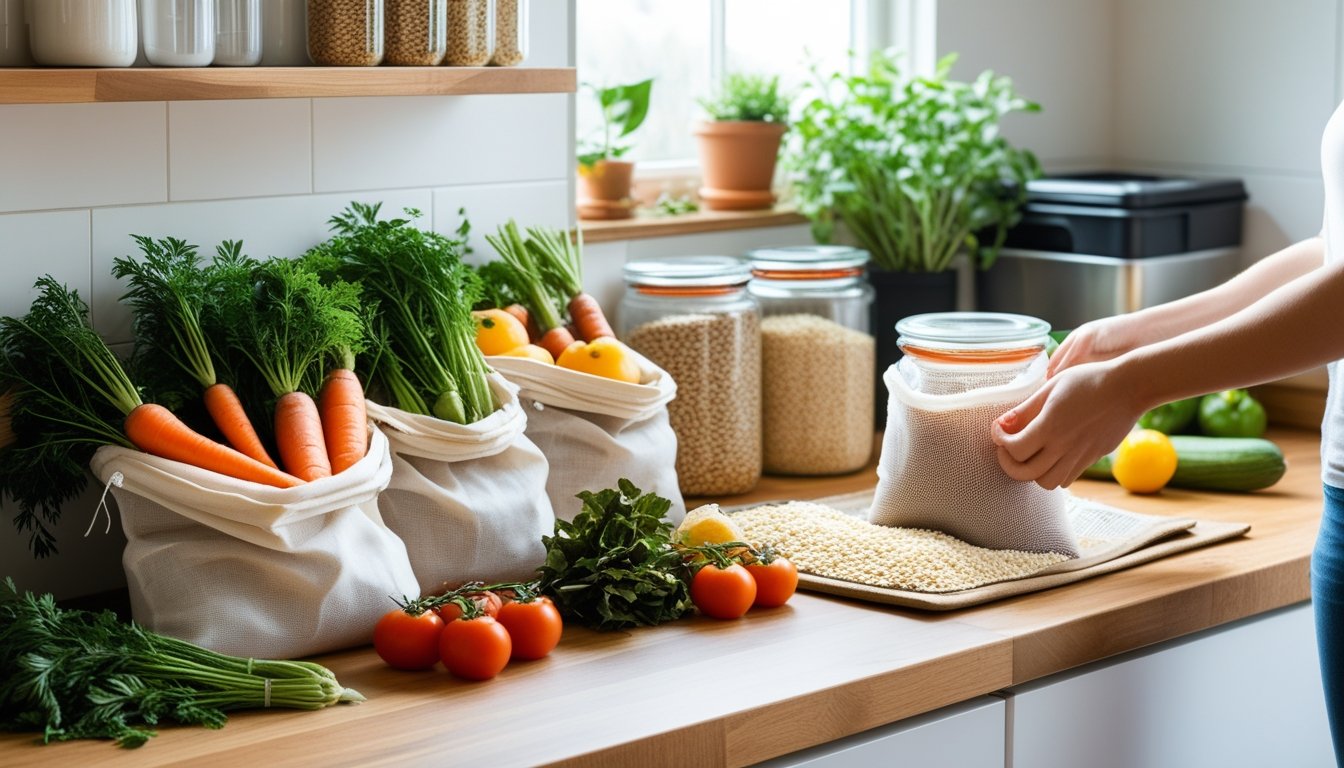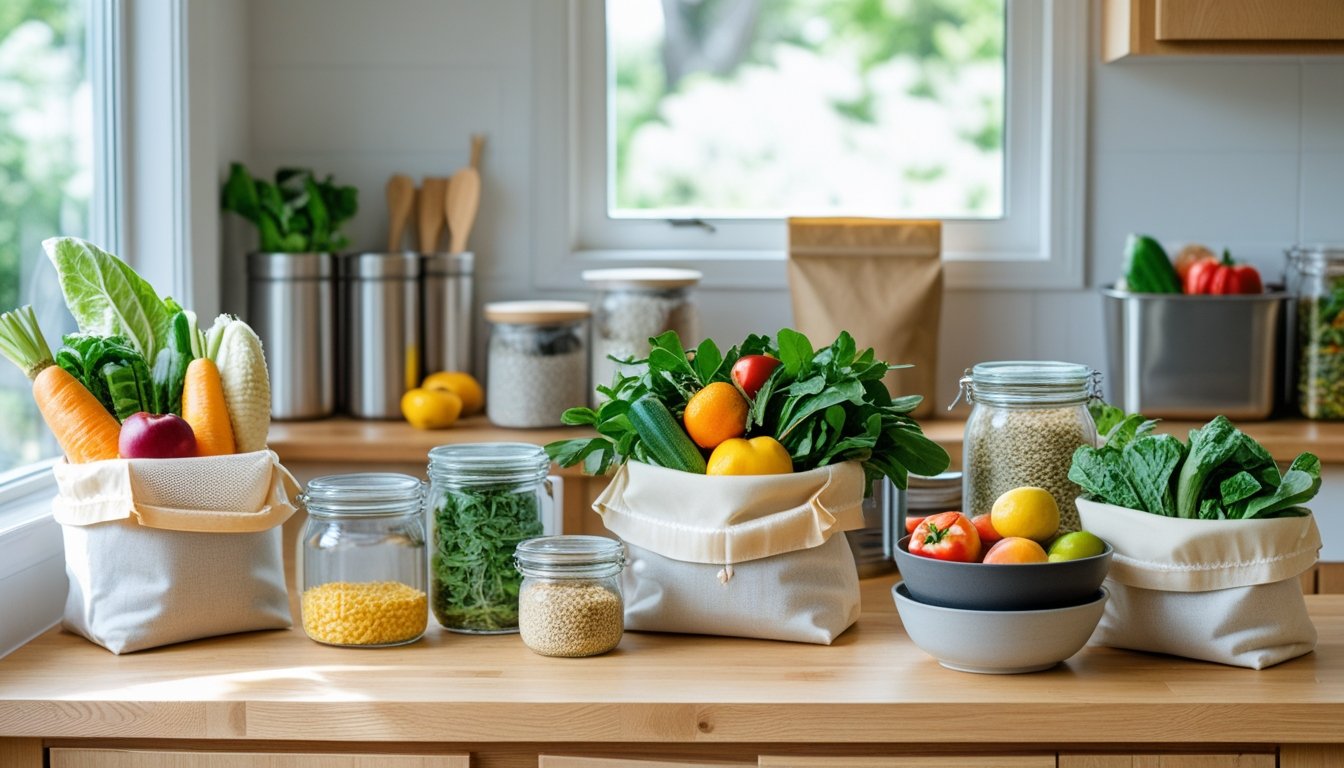Late updated: 25 Aug 2025 13:08
Written by: Sarah Hollister
Eco-Friendly Tips For Reducing Food Packaging Waste: Practical Strategies
Living sustainably is more pressing than ever, and one crucial area we can all focus on is reducing food packaging waste. Reducing food packaging waste not only contributes to environmental preservation but encourages healthier shopping habits for consumers. As we navigate supermarket aisles, it's essential to recognise the impact our choices have on the planet and explore practical ways to minimise this waste.

We have the power to make informed decisions that can significantly change how packaging waste affects our environment. From choosing products with minimal or no packaging to supporting brands that embrace eco-friendly materials, our actions can drive more businesses to prioritise sustainable practices. Each small change adds to a collective effort in protecting our ecosystem.
By incorporating sustainable habits into our daily lives, we support a broader movement toward building a resilient and responsible food system. Through sharing knowledge and actionable tips, we can work together to create a future with less waste and more mindful consumption.
Key Takeaways
- Make conscious choices to reduce packaging waste.
- Support brands that use sustainable materials.
- Adopt sustainable shopping habits for a better future.
Core Strategies for Reducing Food Packaging Waste
Reducing food packaging waste is critical for environmental sustainability. By choosing products with minimal packaging, switching to reusable solutions, and embracing eco-friendly materials, we can significantly diminish our waste footprint.
Opting for Products with Minimal Packaging
Choosing products with minimal packaging reduces the amount of waste we generate. Many food items come with excessive layers of plastic or cardboard that are often unnecessary. Fruits and vegetables, for example, can usually be purchased without any packaging at all. When we actively seek out products with simpler and less packaging, we not only decrease waste but also send a message to manufacturers about the demand for sustainable practices.
Farmer's markets and bulk-bin sections in shops often offer products with minimal to no packaging. Supporting brands that focus on reducing packaging materials can help shift industry standards towards more sustainable solutions. Together, by making conscious purchasing decisions, we support eco-friendly practices and decrease overall food packaging waste.
Switching to Reusable Bags and Containers
Reusable bags and containers serve as an effective means of reducing single-use plastics. Cloth bags, glass jars, and bamboo utensils are excellent alternatives to their disposable counterparts. For instance, bringing our own bags to the grocery store eliminates the need for plastic or paper bags entirely. Many stores even offer incentives or discounts for doing so.
Reusable containers also play a critical role in food storage and transportation. By using them, we reduce not only packaging waste but also the cost and environmental impact associated with frequent disposal. Embracing these practices habitually helps us minimise our ecological footprint and foster habits that support sustainability.
Choosing Eco-Friendly Packaging Materials
Opting for eco-friendly packaging materials supports waste reduction and sustainability. These materials, such as biodegradable plastics, recycled paper, and plant-based polymers, are designed to break down more easily in nature compared to traditional packaging. By selecting products wrapped in sustainable materials, we contribute to a decrease in packaging waste.
Brands committed to eco-friendly packaging often label their products accordingly. Look for certifications or symbols that indicate the use of recycled or renewable materials. Supporting these brands encourages broader industry change towards sustainable packaging, helping us align with our environmental values.
Shopping in Bulk and Using Refill Stations
Shopping in bulk and utilising refill stations significantly reduce packaging waste. Many supermarkets and speciality stores offer bulk sections where customers can purchase the exact amount needed without excess packaging. Grains, nuts, and spices can be bought in larger quantities, allowing us to reuse containers and bags we already own.
Refill stations for items such as cleaning supplies and personal care products replace the need for new plastic bottles or packaging each time we need to restock. By incorporating these practices, we reduce our dependence on single-use packaging and take active steps towards a sustainable lifestyle.
Supporting a Sustainable Food System

Promoting sustainability in food systems requires active participation in various areas. By choosing to shop locally, supporting brands committed to reducing their environmental impact, and engaging in composting and recycling initiatives, we move towards a more sustainable future.
Shopping Locally and Supporting Sustainable Brands
When we buy from local producers, we help cut down the carbon footprint associated with long-distance transportation of goods. Fresh produce from local farmers not only supports regional economies but also ensures fresher options. Additionally, sustainable brands often make bold commitments to reducing pollution, using eco-friendly packaging solutions, and adopting circular economy principles. Prioritising these brands in our choice of products encourages wider industry adoption of environmentally-conscious practices, effectively reducing food waste and resource consumption.
Advocating for Packaging Solutions with Reduced Environmental Impact
Packaging plays a vital role in sustainability, and advocating for solutions with reduced environmental impact is essential. Sustainable packaging options, like biodegradable, recyclable, and compostable materials, are key to lowering pollution and greenhouse gas emissions. Supporting policies and initiatives that promote these alternatives is crucial. As consumers, we can campaign for packaging that contributes less to landfill and instead promotes reuse or degradation through composting programs. By voicing our support for environmentally-responsible practices, we encourage businesses to innovate and implement effective packaging solutions tailored to reducing waste.
Participating in Composting and Local Recycling Programmes
Local composting and recycling programmes significantly aid in reducing food and packaging waste. By participating in these initiatives, we ensure that organic waste is appropriately decomposed, turning it into nutrient-rich compost rather than contributing to harmful landfill emissions. Local recycling efforts further support the reduction of pollution by diverting waste from landfills and fostering a circular economy. Engagement in these programmes requires us to be proactive in separating waste, understanding what is recyclable or compostable, and following local guidelines to enhance the efficiency of waste management systems. Through these actions, we collectively minimise our impact on the environment, promoting a more sustainable food system.
Frequently Asked Questions

Reducing food packaging waste is a shared responsibility that can start with daily habits and extend to business practices. Our approach here is to address key consumer and business concerns to foster environmentally friendly actions.
How can consumers effectively reduce plastic packaging in their weekly food shop?
We can bring reusable bags, choose loose produce, and opt for bulk buying to reduce plastic packaging. Seeking out products packaged in recyclable or biodegradable materials can also make a notable difference. It's about making conscious choices that align with sustainability goals.
What are the best ways to store food in order to minimise spoilage and reduce waste?
To keep our food fresher for longer, we can store items in airtight containers or use beeswax wraps as an alternative to plastic. Keeping our fridge organised helps monitor what we have, reducing unnecessary purchases and spoilage.
Which are the most effective methods for composting food scraps at home?
Composting can be easily done with kitchen scraps. We can compost fruit and vegetable peels, coffee grounds, and eggshells. A simple compost bin in the garden or kitchen can turn waste into nutrient-rich soil, promoting a circular food system.
What strategies can businesses adopt to cut down on their food packaging waste?
Businesses should focus on redesigning their packaging to use less material. Implementing recycling programs and choosing suppliers who prioritise sustainable materials are excellent strategies. Educating staff and customers about these initiatives can promote broader participation.
How can we utilise food by-products such as husks and peels in a sustainable manner?
Food by-products can be repurposed creatively. For instance, citrus peels can be used in cleaning products, and coffee grounds can be employed in exfoliating scrubs. These practices can reduce waste and create additional value from materials often discarded.
What are the key components to include in a food waste audit for a household or business?
A thorough food waste audit involves tracking what and how much is thrown away. Identifying patterns and peak waste times helps us adjust purchasing and usage. Establishing clear goals and measuring progress encourages long-term waste reduction efforts.
